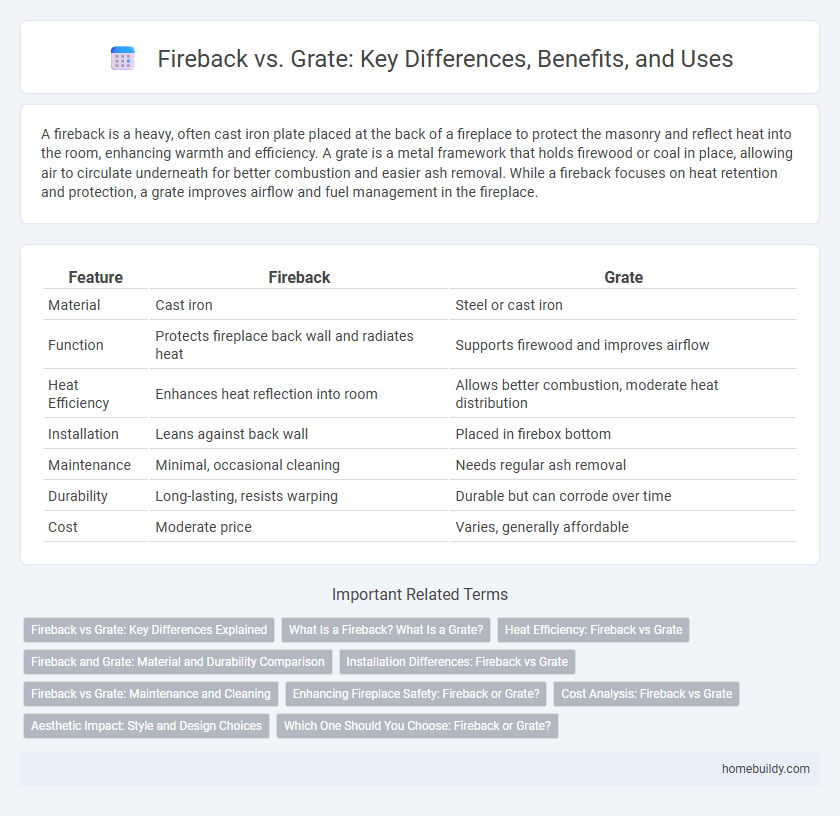A fireback is a heavy, often cast iron plate placed at the back of a fireplace to protect the masonry and reflect heat into the room, enhancing warmth and efficiency. A grate is a metal framework that holds firewood or coal in place, allowing air to circulate underneath for better combustion and easier ash removal. While a fireback focuses on heat retention and protection, a grate improves airflow and fuel management in the fireplace.
Table of Comparison
| Feature | Fireback | Grate |
|---|---|---|
| Material | Cast iron | Steel or cast iron |
| Function | Protects fireplace back wall and radiates heat | Supports firewood and improves airflow |
| Heat Efficiency | Enhances heat reflection into room | Allows better combustion, moderate heat distribution |
| Installation | Leans against back wall | Placed in firebox bottom |
| Maintenance | Minimal, occasional cleaning | Needs regular ash removal |
| Durability | Long-lasting, resists warping | Durable but can corrode over time |
| Cost | Moderate price | Varies, generally affordable |
Fireback vs Grate: Key Differences Explained
A fireback is a solid metal plate placed at the back of a fireplace to reflect heat into the room and protect the fireplace structure, while a grate is a metal framework that holds firewood off the floor of the fireplace, allowing air circulation for better combustion. Firebacks primarily enhance heat efficiency and safeguard masonry, whereas grates improve airflow and help maintain a cleaner firebox by containing ash. Choosing between a fireback and a grate depends on whether heat retention or fire management is the primary goal.
What Is a Fireback? What Is a Grate?
A fireback is a thick, often cast iron plate positioned at the back of a fireplace to protect the masonry and reflect heat into the room, enhancing warmth and efficiency. A grate is a metal framework within the fireplace designed to hold firewood or coal off the hearth, allowing air circulation for better combustion and easier ash removal. While firebacks focus on heat retention and protection, grates facilitate fire management and airflow.
Heat Efficiency: Fireback vs Grate
Firebacks significantly improve heat efficiency by absorbing and radiating heat back into the room, unlike grates that primarily support fuel without enhancing heat retention. Made from cast iron or steel, firebacks can increase stove or fireplace thermal output by up to 20-30%, optimizing fuel consumption. Grates facilitate air circulation for combustion but do not contribute to retaining or reflecting heat, resulting in lower overall heat efficiency.
Fireback and Grate: Material and Durability Comparison
Firebacks are typically made from cast iron or steel, materials known for their superior heat retention and resistance to warping under high temperatures. Grates, often constructed from cast iron or steel as well, must endure direct contact with burning logs and the resulting ash, requiring exceptional strength and durability. While both components demand robust materials, firebacks prioritize thermal mass for heat reflection, whereas grates must combine toughness with structural stability to support firewood safely.
Installation Differences: Fireback vs Grate
A fireback is installed at the rear of a fireplace by positioning it directly against the firebox wall, often requiring minimal tools or fasteners, while a grate sits inside the fireplace, elevated by legs, designed to hold wood or coal above the hearth floor. Firebacks need careful measurement to fit precisely and may require mortar or heat-resistant adhesive for secure placement, whereas grates are typically freestanding and easier to move or replace. The installation of a fireback enhances heat reflection and protects masonry, contrasting with grates that improve airflow and combustion efficiency without altering the fireplace structure.
Fireback vs Grate: Maintenance and Cleaning
A fireback requires minimal maintenance compared to grates, as it primarily involves occasional ash removal and surface cleaning to prevent rust. Grates demand more frequent upkeep, including clearing ash buildup and inspecting for warping or damage due to constant exposure to high heat. Proper cleaning of a fireback ensures optimal heat reflection and longevity, while maintaining a grate is crucial for ensuring proper airflow and combustion efficiency.
Enhancing Fireplace Safety: Fireback or Grate?
Firebacks, made of solid cast iron or steel, enhance fireplace safety by reflecting heat back into the room and protecting the masonry from intense heat damage. Grates elevate firewood off the hearth, improving air circulation and reducing the risk of embers spilling onto the floor, which prevents accidental fires. Choosing between a fireback and a grate depends on prioritizing heat efficiency and structural protection versus improved airflow and ember containment.
Cost Analysis: Fireback vs Grate
Firebacks generally have a higher upfront cost compared to grates due to their durable cast iron construction and heat-retention properties. Over time, firebacks can reduce heating expenses by reflecting more heat into the room, offering better energy efficiency than standard grates. Grates, while cheaper initially, may require more frequent replacement and provide less effective heat distribution, impacting long-term cost-effectiveness.
Aesthetic Impact: Style and Design Choices
Firebacks offer a sleek, often ornate design that serves as a focal point within a fireplace, enhancing its visual appeal with intricate patterns or classic motifs. Grates prioritize functionality and airflow, typically featuring simpler, utilitarian designs that emphasize durability over decoration. Choosing between a fireback and a grate depends on whether aesthetic impact or practical heat distribution is the primary concern for the fireplace setup.
Which One Should You Choose: Fireback or Grate?
A fireback enhances heat reflection and protects the fireplace's back wall, creating higher warmth efficiency compared to a grate, which primarily supports wood for better airflow and combustion. Firebacks are ideal for maximizing heat radiation and preserving chimney structure, whereas grates improve burning efficiency and ease of cleaning ash. Choose a fireback for superior heat output and durability; opt for a grate if you prioritize fuel management and fire maintenance.
Fireback vs Grate Infographic

 homebuildy.com
homebuildy.com